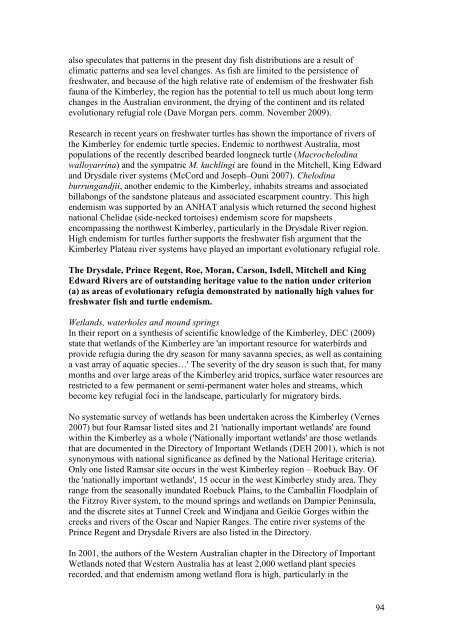WEST KIMBERLEY PLACE REPORT - Department of Sustainability ...
WEST KIMBERLEY PLACE REPORT - Department of Sustainability ...
WEST KIMBERLEY PLACE REPORT - Department of Sustainability ...
Create successful ePaper yourself
Turn your PDF publications into a flip-book with our unique Google optimized e-Paper software.
also speculates that patterns in the present day fish distributions are a result <strong>of</strong><br />
climatic patterns and sea level changes. As fish are limited to the persistence <strong>of</strong><br />
freshwater, and because <strong>of</strong> the high relative rate <strong>of</strong> endemism <strong>of</strong> the freshwater fish<br />
fauna <strong>of</strong> the Kimberley, the region has the potential to tell us much about long term<br />
changes in the Australian environment, the drying <strong>of</strong> the continent and its related<br />
evolutionary refugial role (Dave Morgan pers. comm. November 2009).<br />
Research in recent years on freshwater turtles has shown the importance <strong>of</strong> rivers <strong>of</strong><br />
the Kimberley for endemic turtle species. Endemic to northwest Australia, most<br />
populations <strong>of</strong> the recently described bearded longneck turtle (Macrochelodina<br />
walloyarrina) and the sympatric M. kuchlingi are found in the Mitchell, King Edward<br />
and Drysdale river systems (McCord and Joseph–Ouni 2007). Chelodina<br />
burrungandjii, another endemic to the Kimberley, inhabits streams and associated<br />
billabongs <strong>of</strong> the sandstone plateaus and associated escarpment country. This high<br />
endemism was supported by an ANHAT analysis which returned the second highest<br />
national Chelidae (side-necked tortoises) endemism score for mapsheets<br />
encompassing the northwest Kimberley, particularly in the Drysdale River region.<br />
High endemism for turtles further supports the freshwater fish argument that the<br />
Kimberley Plateau river systems have played an important evolutionary refugial role.<br />
The Drysdale, Prince Regent, Roe, Moran, Carson, Isdell, Mitchell and King<br />
Edward Rivers are <strong>of</strong> outstanding heritage value to the nation under criterion<br />
(a) as areas <strong>of</strong> evolutionary refugia demonstrated by nationally high values for<br />
freshwater fish and turtle endemism.<br />
Wetlands, waterholes and mound springs<br />
In their report on a synthesis <strong>of</strong> scientific knowledge <strong>of</strong> the Kimberley, DEC (2009)<br />
state that wetlands <strong>of</strong> the Kimberley are 'an important resource for waterbirds and<br />
provide refugia during the dry season for many savanna species, as well as containing<br />
a vast array <strong>of</strong> aquatic species…' The severity <strong>of</strong> the dry season is such that, for many<br />
months and over large areas <strong>of</strong> the Kimberley arid tropics, surface water resources are<br />
restricted to a few permanent or semi-permanent water holes and streams, which<br />
become key refugial foci in the landscape, particularly for migratory birds.<br />
No systematic survey <strong>of</strong> wetlands has been undertaken across the Kimberley (Vernes<br />
2007) but four Ramsar listed sites and 21 'nationally important wetlands' are found<br />
within the Kimberley as a whole ('Nationally important wetlands' are those wetlands<br />
that are documented in the Directory <strong>of</strong> Important Wetlands (DEH 2001), which is not<br />
synonymous with national significance as defined by the National Heritage criteria).<br />
Only one listed Ramsar site occurs in the west Kimberley region – Roebuck Bay. Of<br />
the 'nationally important wetlands', 15 occur in the west Kimberley study area. They<br />
range from the seasonally inundated Roebuck Plains, to the Camballin Floodplain <strong>of</strong><br />
the Fitzroy River system, to the mound springs and wetlands on Dampier Peninsula,<br />
and the discrete sites at Tunnel Creek and Windjana and Geikie Gorges within the<br />
creeks and rivers <strong>of</strong> the Oscar and Napier Ranges. The entire river systems <strong>of</strong> the<br />
Prince Regent and Drysdale Rivers are also listed in the Directory.<br />
In 2001, the authors <strong>of</strong> the Western Australian chapter in the Directory <strong>of</strong> Important<br />
Wetlands noted that Western Australia has at least 2,000 wetland plant species<br />
recorded, and that endemism among wetland flora is high, particularly in the<br />
94
















